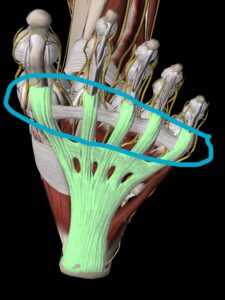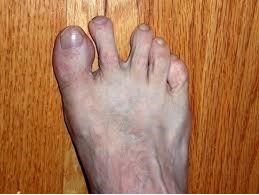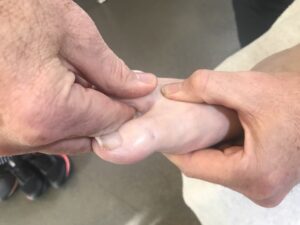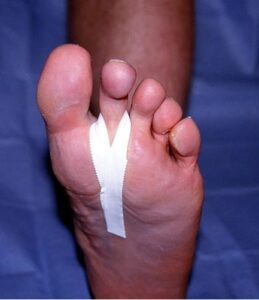Plantar Plate Injuries
Plantar Plate Injuries fall under the category of forefoot pain problems, but they make up a significant percentage of forefoot problems so I have decided to discuss this condition exclusively.
What Is the Plantar Plate?

Plantar Plate
The plantar plate is a fibrous structure that has a cartilaginous plate that makes the tissue stiffer than normal ligaments and tendons. The plantar plate sits under the metatarsal heads (the ball of the foot) The plantar plate acts to keep the toe and the joint from separating. When walking, the toes will bend at the base of the toe joint just before the foot pushes off the ground. The plantar plate holds the toe in place and brings the toe back straight. In some cases, this ligament can become overstretched or “tear” causing pain and deformity to the area, leading to a gradual dislocation of the toe.
The plantar plate aids movement across the forefoot around the metatarsal head region. It helps to stabilise toes and provides strength to the forefoot area for the body weight to transition over. Different amounts of flexibility in this area and joint mobility can influence the pressure and tension this tissue is under.
What goes Wrong with the Plantar Plate?

Grade 2 Plantar Plate Injury with Associated Toe Deformity
Unfortunately, what happens in this area is that the high load and chronic strain can produce micro tears and slow degradation of the tissue in and around the planter plate. This makes the tissue less able to deal with the load that it is under. Plantar plate injuries are generally more common if the tissue is under high velocity loading such as running, jumping, or taking off. Activities that bend the toes back can also aggravate this area. It can be a one-off trauma or a repeated strain type injury. Poor footwear can also aggravate this area as can some playing or walking surfaces.
The small tears can cause ongoing instability of the area. This instability can start to cause irritation of the joint capsule. Clinically this can be seen when toes are misplaced and retracted (pulled back) with pain and swelling in the area. Often this will coincide with bursitis and in the worst cases can result dislocation of the toe joint.
The Most Common Areas for Plantar Plate Injuries:

Dorsal Draw Test
- The second toe accounts for 70%
- The third toe 15 %
- Other toes 15%
Diagnosis of Plantar Plate Injuries:

Stirrup Strapping
There is a four stage grading for plantar plate injuries. These are primarily concerned with the amount of flexibility in the toe joint. Diagnosis largely hinges around clinical tests such as the draw test, paper grip propagation test and deviation of the digits as well as the presentation of pain. Sometimes ultrasound imaging is used and x-rays can be used to confirm the clinical suspicion and aid in the diagnosis.
Treatment of Plantar Plate Injuries:
Treatment is only done after diagnosis and treatment is relative to the degree of the injury. Sometimes a stirrup strapping can be used and footwear is very important for an ongoing good outcome. An orthotic can help reduce a lot of pain in the area as well. This problem is rarely operated on surgically due to the high loads and small space of the area.
If you suspect you may have an issue with your plantar plate, give us a call to book an appointment. We’ll give you an accurate diagnosis and individual treatment plan to suit your particular needs and situation.
Do You Have a Plantar Plate Issue?
Are you are feeling like you have tried everything but are still suffering from Plantar Plate pain?
Do you feel like you have seen every health practitioner you can about your plantar plate condition with no results?
We have a track record of diagnosing and successfully treating cases that have previously proven difficult to resolve and we’d love to help you get the problem sorted.

